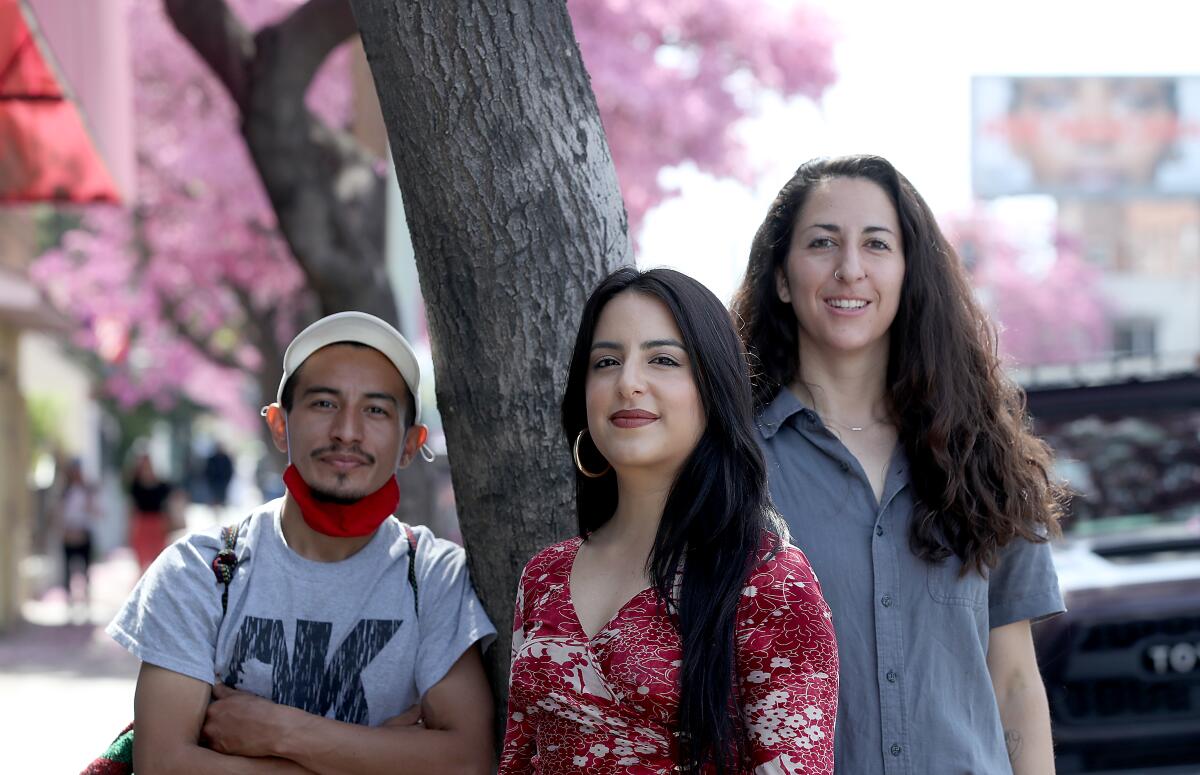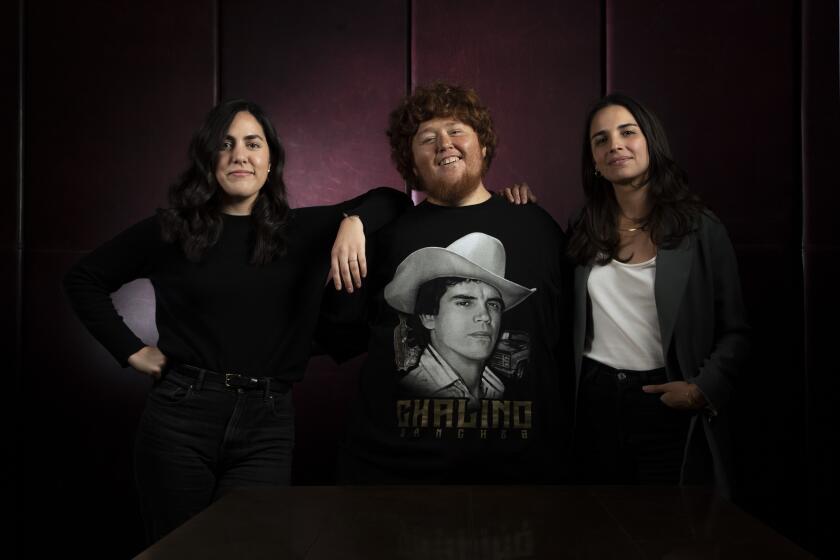For $5 a month, three East Hollywood residents want to change L.A. journalism

- Share via
Samanta Helou Hernandez is a freelance journalist. Jimmy Recinos is a middle school English teacher. Ali Rachel Pearl is a postdoctoral fellow at USC.
The millennials are residents of the Virgil Village neighborhood in East Hollywood, where working-class businesses have slowly transformed into hipster havens over the last decade.
Together, the friends want to transform journalism in Los Angeles.
Helou, Pearl and Recinos are all veterans of documenting gentrification through just about every new medium that has emerged for independent reporters over the last generation: blogs, podcasts, Zoom sessions, Instagram accounts, videos, community forums, glossy magazines.
The three did all of their individual and collective projects for free, or close to it. But altruism doesn’t pay rent or create sustainable models, so they’re ready to level up.
Enter Making a Neighborhood, a Substack newsletter that’s an easy way to distribute their work and posits East Hollywood, and especially Virgil Village — which is barely bigger than a square mile — as a case study in how communities rise, fall and resist.
For $5 a month, you can subscribe and enjoy a minimum of four original pieces a week.
Helou launched the project last week with a photo essay profiling the former vendors of an indoor swap meet demolished to make way for a seven-story mixed-use project.
Pearl, who has lived in Virgil Village for a decade, offered an essay on how a white suburbanite Coloradoan like herself ended up becoming an anti-gentrification activist.
Recinos, an East Hollywood native, is working on a reported story that ties the idea of his neighborhood as a multicultural crossroads to the pobladores who founded Los Angeles.

There are some community-based journalism projects — The Eastsider, L.A. Taco, TheLAnd Magazine — in Los Angeles that rely on subscriptions and donors while giving away their work for free.
Making a Neighborhood goes beyond freebies, throwing down a challenge to people who bemoan the loss of local news but won’t shell out what amounts to a monthly latte: Pay up.
Indie media outlet L.A. Taco tells L.A. City Councilman Jose Huizar’s story in a podcast as only L.A. Taco can.
Charging for the chance to read Making a Neighborhood is “an affirmation of the worth of the work,” said the 31-year-old Recinos.
“If we were all trust fund kids, sure — why not make it free?” said Pearl, 33. “But we just can’t afford to work for free. No journalist should, for that matter.”
“We’re like Power Rangers that came together with our skills,” said Helou, who just turned 30. “It’s taking a gamble on ourselves, but we feel we can do it.”
Helou and her partners recently went on Instagram Live to pitch Making a Neighborhood to friends and strangers alike.
The stories they teased for future newsletters made me sign up almost immediately. A dive into the spectacular trumpet trees that line Virgil Avenue and are blooming right now. The queer history of East Hollywood. An interview with the neighborhood’s UPS driver, who has delivered packages there for 17 years.
“We have visions, y’all,” Recinos told their audience as Helou and Pearl smiled and nodded.

The day of that IG Live chat, I asked Helou to meet me at a place that she felt best exemplified what she and her friends wanted to cover. She chose California Grill, a Salvadoran restaurant whose marquee is a palimpsest of past incarnations as an American and Mexican diner. Kitty-corner from us was a bagel spot with no signage and a hipster-filled line that wrapped around the corner.
“The New York Times wrote about it, and it became a huge thing,” Helou said about the bougie bagels while sipping on an agua de jamaica. “It used to be a Guatemalan-owned bakery. That’s now in South L.A.”
Originally from Mexico City by way of Escondido, she arrived in Virgil Village in 2014 while attending USC. She started covering her new neighborhood with This Side of Hoover, an Instagram account pairing photos of local entrepreneurs with short interviews to document what was disappearing before her eyes.
“The gentrification was already here, but it wasn’t in your face until it was,” Helou said.
This Side of Hoover quickly got national attention when it launched in 2018 — and a message from Recinos. Since 2014, he had run Jimbo Times, a website where he and others told street-level stories about East Hollywood and beyond.
“I thought I was alone here, but he sure schooled me!” Helou said with a laugh.
“I wanted to know what her M.O. was,” Recinos admitted. The two quickly began to collaborate once they realized they shared the same aims, if not mediums.
“We’ve gotta uplift our platforms,” he said. “Let’s bring the minds together and organize and make something memorable for our community.”

Helou and Recinos ramped up their projects during the pandemic, as East Hollywood’s stratification became even more pronounced.
Recinos began a podcast called J.T. the Storyteller; Helou co-authored a withering takedown of Sqirl, the much-hailed Virgil Village bistro that critics called out for cultural appropriation and moldy jam.
Companies like Sonoro and Futuro are finding success with Latino-focused podcasts. Major producers like Spotify and iHeart are following suit.
The two consulted on a pamphlet in five languages — English, Spanish, Thai, Tagalog and Armenian — that told the history of housing segregation in East Hollywood, personally delivering them to businesses and residents.
They also held community forums. That’s how they met Pearl, who suggested they do a public art installation that consisted of posting signs across East Hollywood and Silver Lake that read, “This Neighborhood Was Redlined.” Helou took photographs; Recinos wrote a multipart history.
“We realized we worked so well together as a trio, and we feel better about life working together, so we wanted to continue,” Pearl said.
Making a Neighborhood’s immediate goal is modest: 1,000 paying subscribers (there’s a free option that gets cheapskates one post a month). But Helou, Pearl and Recinos want to make enough money to not just pay themselves but also to commission freelancers in East Hollywood to tell their own stories.
And the biggest dream? Inspire community journalists and residents in other neighborhoods to start their own paid newsletters.
“If people are informed, then they could feel more in control, because information is power,” Helou said.
“This is local work, but it’s local work that speaks to a national situation,” Pearl said.
“I want to encourage more storytellers to bring their stories up from wherever they’re standing,” Recinos said. “At the very least, the rest of the city can know that we’re here, and we’re pushing.”
More to Read
Sign up for Essential California
The most important California stories and recommendations in your inbox every morning.
You may occasionally receive promotional content from the Los Angeles Times.














